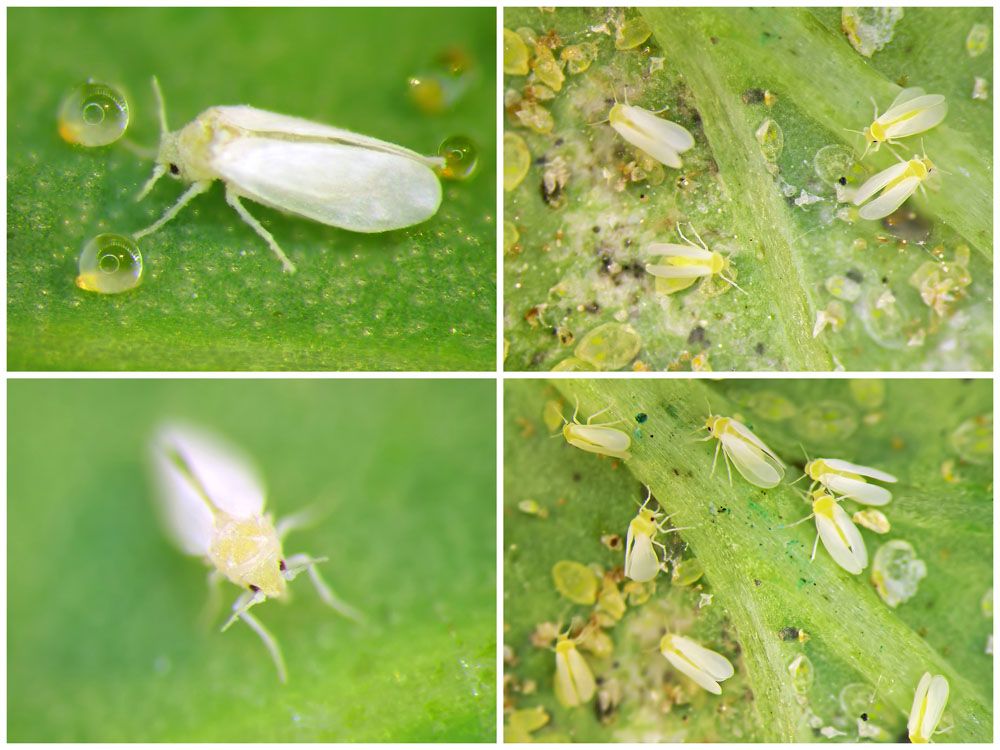
Silverleaf Whitefly – Bemisia argentifolii
Silverleaf Whitefly – Bemisiaargentifolii
Common Name: Silverleaf Whitefly
Latin Name: Bemisiaargentifolii
Appearance:
Adults: The silverleaf whitefly is smaller and yellower than most other whitefly pests of flowers (approximately 0.96 mm in the female and 0.82 mm in the male). The antennae are significant on the head, and the mouth portions are small. The wings are roof-like at around a 45-degree angle, whereas most whiteflies keep their wings nearly flat over the body. As a result, the silverleaf whitefly seems slimmer than other common whiteflies.
Eggs: The eggs are placed on the undersides of fresh leaves, end to end. The eggs are pale to beige, with the apex somewhat darker.
Nymphs: Depending on the leaf qualities, the nymphal stages appear glassy to opaque yellowish and may or may not have dorsal spines. The body is scale-like and flattened, with the border close to the leaf surface. There is no waxy spine palisade around the rim.
Pupae: The pupa, or fourth nymphal instar, is 0.6 to 0.8 mm long and somewhat more profound, beige-ish-yellow and opaque. Pupae are somewhat plumper than those preceding nymphal stages. White wax deposits are seen at the tip of the anterior and caudal spiracular furrows. The caudal setae are noticeable, and the caudal end is somewhat sharp. When the host leaf is hairy, dorsal spines are present; dorsal spines are missing when the host leaf is smooth.
Host plant:
Favourite hosts include broccoli, cabbage, cotton, melons, squash, and several ornaments (e.g., poinsettia) and native plant species.
Territory:
Silverleaf Whitefly is a common pest in Queensland, New South Wales, and Western Australia, and it has the potential to become a significant problem across most of Australia’s irrigated agricultural areas.
Damages caused by Silverleaf Whitefly:
Silverleaf Whitefly causes crop damage in a variety of ways. Whiteflies that feed on plants defoliate them, stunt them, and reduce their production. Whitefly nymphs and adults emit sticky honeydew, which promotes the formation of black sooty mould on plants. The mould makes cotton harder to process and necessitates washing vegetables, raising manufacturing expenses. Plant physiological abnormalities caused by Silverleaf Whiteflies include uneven tomato ripening and squash silverleaf (hence the common name). Silverleaf whiteflies can transmit a variety of viral plant diseases.
Life history and habits:
(The following observations were made using silverleaf whiteflies that were mistakenly assumed to be sweet potato whiteflies at the time.) Temperature, humidity, and host plant appear to be the primary determinants of development from egg deposition to adult emergence. These timeframes will range from 16 to 38 days, depending on these conditions. The number of eggs laid by each female during her lifespan varies greatly but appears to be in the 80-100 range. There have been reports (in Israel) of nine extremely fecund (300 eggs/females) strains of silverleaf whitefly Crawlers” hatching from the eggs and crawling about until they insert threadlike mouthparts into the underside of the leaf to feed. They tuck their legs and antennae beneath them and huddle close to the leaf surface. Crawlers moult into scales, which also consume sap. Nymphs moult two and three times. The fourth stage develops into a non-feeding pupa. The pupa matures into the adult whitefly. Adults emerge from the pupa approximately a month after the egg is deposited through a T-shaped opening. Females have a lifespan of roughly two weeks.
